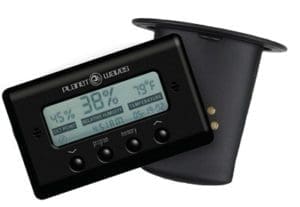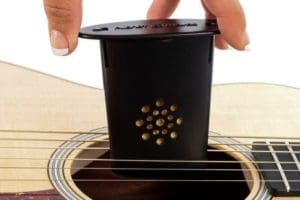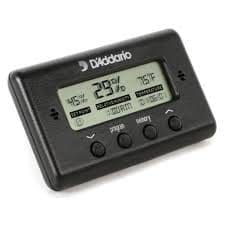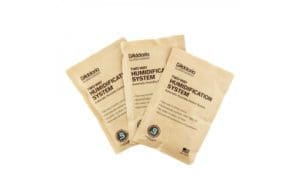Last update 5/2/2024
Most acoustic guitars are constructed almost entirely from wood. While that means they can be somewhat durable based on the quality of their construction and finish. Naturally, they can be damaged by factors that create an ‘unhealthy’ environment (unhealthy for the guitar itself, that is…). Humidity is one of the most common forces of nature (along with extreme temperatures) that can affect the playability and the guitar’s overall construction. If an instrument such as an acoustic guitar is left subject to the wrong humidity levels, things can get nasty.
Table of contents
Guitar Humidity Solutions
About humidity? What are the correct specifications for good guitar health? What can happen if the humidity levels aren’t right?
Also, learn about several top guitar accessories that will add to your guitar-playing experience and maintenance products to keep it in like-new condition.
What is humidity?


Humidity is simply a way of measuring how much water vapor there is in the air. It is often expressed in terms of ‘relative humidity.’ Relative humidity can be defined as the amount of water vapor in the air expressed as a percentage.
Think about going outside on a hot day when a rainstorm may be on the way. The air tends to feel thick and ‘wet.’ In those cases, the relative humidity is typically pretty high.
Here’s a more relevant example: the thing about the last time you went into your local guitar store (yes, I mean an actual brick-and-mortar store, and yes – they still exist in this day and age of internet shopping). Some of them have special rooms dedicated to new acoustic guitars. Did you notice that the overall environment seemed to be a bit warm and muggy? That’s because the relative humidity was set to the right point to keep their inventory in tip-top shape.
Hey – you didn’t expect to get a science lesson today, right? No worries – no homework or tests to take today!
What is the proper relative humidity level for an acoustic guitar?
You’ve probably noticed by now that we’ve been referring pretty much exclusively to acoustic guitars. That’s because acoustic guitars can obtain the most damage from being stored in an environment with an incorrect humidity level (sure, electric guitars can also be affected, but we’ll go into more detail on that later).


The best relative humidity level for an acoustic guitar (based on recommendations from many of the best manufacturers) is typically in the 45% to 55% range. Remember that wood, by its inherent nature, is a porous material – meaning that it is susceptible to humidity. Suppose an acoustic guitar is kept in the wrong environment for a prolonged period. In that case, the effects can range from minor inconveniences to significant damage beyond repair.
Effects of not enough humidity
Suppose an acoustic guitar is stored in an atmosphere with a relative humidity level that is too low. In that case, the most likely effect will be that the wood will shrink due to the lack of moisture. That can lead to issues such as poor playability along with – in extreme cases – severe cracking.
One of our staff writers has some first-hand experience with this – we’d recommend taking this as a vast ‘lessons learned…
“I had just bought my first real acoustic guitar – one that was a level above many beginner-style instruments. While it wasn’t the most expensive guitar on the rack that day, it certainly wasn’t the cheapest – it was the most money I had ever invested in a guitar at the time.
Humidity effects
While I did store it in a decent case, I didn’t know how to care for it. Truthfully, I never even thought about it all that much – and that was a BIG mistake on my part.
Over time, I noticed that the action wasn’t as good as it was when I bought it.
I was beginning to get fret buzz a lot, even to the point that some notes were completely fretting out. I had just figured it needed a setup. However, I didn’t realize at the time that I was seeing warning signs of more significant problems, so I didn’t prioritize fixing them immediately.
About a week later, I opened the case, and – to my absolute horror – there was a massive crack on the top (it was a solid spruce top, by the way) that ran from the bottom of the bridge to the end of the guitar by the endpin for the strap. I called the store I bought it from, and they told me I hadn’t kept it at the proper humidity level – it had dried out to the point of failure.
So I got a guitar humidifier to fix the problem, but the damage had been done. Sometime later, the entire bridge lifted off the top. The moral of the story? If you invest in a top-notch acoustic guitar, educate yourself on proper care for it. If you don’t, the result may be catastrophic.”
True story, sad to say…but it happens to more acoustic guitars than you may think.
Effects of too much humidity
Having an acoustic guitar live with too much relative humidity can be just as bad as not having enough. High relative humidity levels will make the wood too ‘wet.’ While it surely won’t crack, there are adverse effects that can be just as damaging.
You most likely experience a too-wet guitar that the wood will swell up. That can lead to:
- Unusually high-string action
- Poor tone due to the extra water that is being held in the wood
- Failure of glued joints
- Finish defects
- Distortion of various parts of the guitar (such as the neck)
What’s worse is that some of the damage can be permanent – even if the guitar is stored in the proper relative humidity environment. Some conditions may correct themselves, but extreme wood distortion may be hard – if not impossible – to reverse once it occurs.
Guitar humidifiers
The best way to combat the effects of improper relative humidity on your guitar is to keep it in a controlled environment. That being said, it’s probably safe to say that most guitar players do not have a separate room to store their instruments. Particularly one with relative humidity set to that 45%-55% ‘sweet spot.’
So what’s a guitar player to do?


That answer is simple – store your guitar in a quality case and use a ‘guitar humidifier.’ These accessories keep moisture in the air, and using them while your guitar is contained in a case is probably the next best thing to having a fancy room set up in your home.
There are several different types of guitar humidifiers. For the most part, they are reasonably inexpensive. The process and technologies used can vary quite a bit. It’s good to understand how the different kinds work in practice.
Water (sponge) based guitar humidifiers.
These are the simplest types of guitar humidifiers that you may come across. They are nothing more than a plastic shell with vent holes in them. Typically, there is a cap on the body of the cover that can be removed. Inside, there is nothing more than a simple sponge.
Procedures
To use this type, the sponge has to be damp. Notice we said damp – not wet. It’s easy to think that having the sponge be as moist as possible will help with the humidity. However, you actually may be taking a chance of damaging your acoustic.
The sponge should never be so wet that it can drip from the shell. Why? Well…water and wood tend not to play well together!
“Once in a while, the thumb that fits over the neck of the guitar kinda bothers me a little bit, but not that much yet. I figure in time I won’t do much because of my age.” B. B. King
Guitar humidifiers of this type are designed to fit between the strings and protrude into the guitar’s body. The body is where the thinnest wood pieces on an acoustic are. Therefore it’s the area that can be most affected by improper humidity.


While sponge-type humidifiers are cheap and easy to use, there are drawbacks. First, no guitar case (or even a high-quality gig bag) is air-tight.
That means, over time, the water vapor inside the case will eventually evaporate. The sponge will become dried out. It’s not uncommon that it may need to be re-wet a few times a week.
Mold
Plus – and this is another real-life example here. There can be problems with mold. Care must be taken to ensure the sponge is always in good shape. Mold can start to grow, and when it does, it’s best to throw that sponge away and get a new one. You can find multi-packs of sponge refills reasonably comfortable.
Another challenge to using sponge-based guitar humidifiers is that you cannot know the relative humidity inside the case. To solve this problem, some accessory manufacturers offer kits, including a guitar humidifier and a ‘digital hygrometer.’ It’s essentially a sensor that measures relative humidity and has a display so you can quickly tell if your case is too dry or too wet.


Humidifier setups with digital hygrometers may cost more and take more effort to use correctly. Still, it’s a more accurate method of ensuring your acoustic guitar’s environment is correct for proper storage.
‘Automatic’ fluid packs
Another option that dramatically reduces the guesswork in keeping the relative humidity needs to be automated fluid-filled packs. These packs are pretty innovative. They are constructed from a particular type of paper enclosure, a proprietary gel-like material sealed inside it.
The combination of the paper and the gel allows an exchange of water vapor within your guitar case. They self-regulate the relative humidity. More moisture is released when the humidity is too low, and excess is absorbed when too high. The design keeps the humidity percentage right where it needs to be. In addition, without messy sponges or the need for checking a digital hygrometer.
Regular replacements
Sounds too good to be true. Well, there’s no denying that this type of system is most likely the easiest and most trouble-free way to keep things on point. But there are a few downsides. First off, the packs will wear out and eventually lose all effectiveness over time. Depending on the overall environment where the guitar is being stored, it can take a few weeks or months.
Since the packs wear out, that means they have to be replaced. And that means you have to purchase new ones continually. The overall cost to use the fluid pack option can add up to several times over what a cheap sponge-type model will cost – even if you factor in a digital hygrometer price.


As with most things, though, convenience comes at a price. If you want to just ‘set it and forget it,’ and you don’t mind paying a few bucks now and then, using fluid packs may be your best choice.
Effects of humidity on different types of guitars
We have focused on humidity and guitars, mainly on acoustic guitars. That’s because they are the most fragile type of guitar that you will come across. The construction is composed of relatively thin pieces of wood, and all of the joints are also secured with adhesives.
Electric guitars
Electric guitars are typically much more robust than acoustic guitars. Solid-body models are remarkably rugged, as they should be. They are solid slabs of thick wood frequently screwed together (the neck-to-body joint). But can improper humidity affect electric guitars as well?
It sure can, just not in the same extreme ways as an acoustic can be. Considering the entire instrument can become damaged beyond repair. You can tell when things get too dry with an electric when you feel the frets’ edges as you play up and down the neck. This means the neck itself has shrunk.
Extreme cases of being too dry or too wet can lead to poor playability and possible neck twisting and warping. So yes – electrics are also susceptible to the effects of poor humidity control.
Acoustic guitars with laminated wood


Another type of guitar to consider is an acoustic that uses laminated wood in its construction. Laminated wood is several thin pieces of wood that are glued together, similar to plywood. Many lower-cost guitars are constructed entirely with this kind of material, mainly because lower and laminated wood can be more substantial than solid pieces.
Mostly, mid-to-high-level acoustic guitars are made with a solid top. Typically, some spruce with laminated backs and sides. Here is where the strength is a benefit. The solid tops tend to sound better and have more efficient vibration transfer. However, improper humidity levels can be affected much more than laminated tops.
While laminated tops are more robust, they aren’t bulletproof. They may not get damaged as easily by humidity as a solid top. But it may not hurt to use some guitar humidifier to be safe.
How much unacceptable relative humidity levels can affect your guitar can’t be overemphasized. The best strategy to combat any ill effects is to be proactive. Use some guitar humidifiers to keep the relative humidity percentage acceptable. And while it’s true that some types of guitars other than solid top acoustics may withstand improper humidity better than others. It’s always better to be safe than sorry.
Humidity is a natural condition that can’t be avoided entirely. If you stay mindful, proper attention to its effects should be a part of any guitar player’s overall guitar maintenance plan. You can be assured of a beautiful playing experience for many years to come.
Summary
Wood is the perfect material for an instrument such as an acoustic guitar. Still, it is far from being ‘hands-off’ or ‘carefree.’ Any instrument needs to be correctly taken care of. Keeping an eye on the humidity levels is critical to keep your guitar playing, sounding, and looking as it did on the day you brought it home.
An acceptable range of relative humidity will keep your guitar happy. Spending some limited time in a dry or wet environment doesn’t always cause concern. We all have been in situations where the room is too dry or played an outside gig with very muggy air. The key is to keep it stored under the right conditions as much as possible.
Transparency disclosure: Some of the links in this post are affiliate links, meaning that I may earn a commission if you click on a link and make a purchase. This commission comes at no extra cost to you. We only recommend products and services that I believe are helpful and valuable, and we never let the potential for a commission influence our recommendations.
Amazon- D’Addario Accessories Acoustic Guitar Humidifier with Digital Humidity & Temperature Sensor



